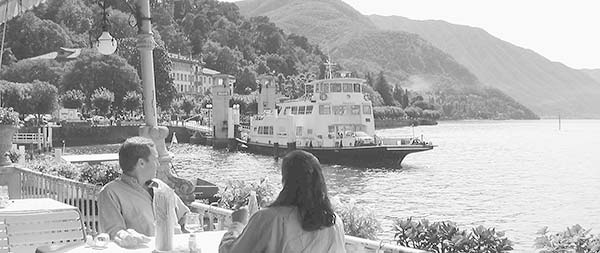
Lake Como • Varenna • Bellagio • Lake Maggiore
Sights and Activities in Varenna
Sights and Activities in Bellagio
Map: Stresa & the Borromeo Islands
Commune with nature where Italy is joined to the Alps, in the lovely Italian lakes district. In this land of lakes, the million-euro question is: Which one? For the best mix of accessibility, scenery, and offbeatness, Lake Como is my choice—and I stay in the village of Varenna. The town of Bellagio on the same lake is a good second choice. And Lake Maggiore is a suitable backup. Enjoying either place, you’ll get a complete dose of Italian-lakes wonder and aristocratic-old-days romance.
You could spend a busy day side-tripping from Milan (about one hour away by train) to either lake, do some island- and villa-hopping, and be home in time for dinner. But the lakes are an ideal place to slow down and take a break from your busy vacation. Settle in here, and bustling Milan doesn’t even exist. Now it’s your turn to be chiuso per restauro (closed for restoration). If relaxation’s not on your agenda, the lakes shouldn’t be either.
Lake Como (Lago di Como)—lined with elegant 19th-century villas, crowned by snowcapped mountains, and busy with ferries, hydrofoils, and slow, passenger-only boats—is a good place to take a break from the intensity and turnstile culture of central Italy. It seems like half the travelers you’ll meet have tossed their itineraries into the lake and are actually relaxing.
Lake Como is Milan’s quick getaway, and the sleepy mid-lake village of Varenna is the handiest base of operations. With good connections to other mid-lake towns (and Milan), Varenna is my favorite home base for exploring the lake. While Varenna has a village vibe, beautiful Bellagio has earned its ritzy allure and feels a bit more like a resort.
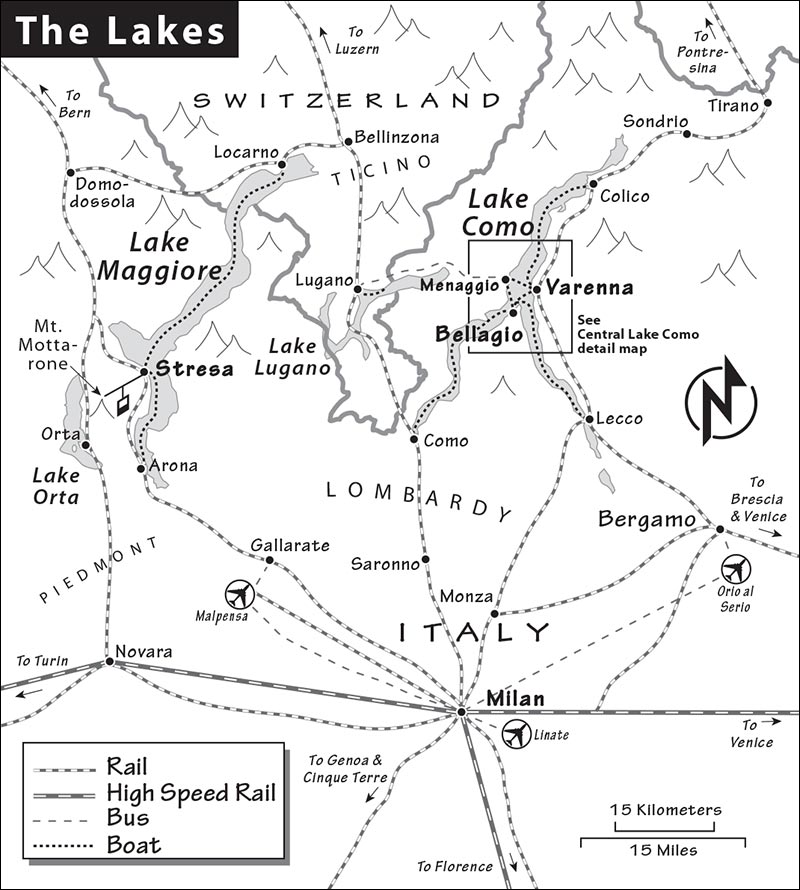
The hazy, lazy lake’s only serious industry is tourism. In fact, every day lots of lakeside residents commute to work in Lugano, just across the border in Switzerland, for a good paycheck. The lake’s isolation and flat economy have left it pretty much the way the 19th-century Romantic poets described it: heaven on earth.
Even though there are no essential activities, plan for at least two nights so you’ll have an uninterrupted day to see how slow you can get your pulse. Spend some time exploring your home base town, take my self-guided ferry tour to view the scenery (with visits to the lake’s two main villas), and hop off the boat to poke around the town you’re not staying in. With additional time, visit more lakeside villas or go for a hike.
Lake Como is also workable as a day trip from Milan. Take a morning train to Varenna, ride the boat to Lenno (and tour Villa Balbianello), then take a boat to Villa Carlotta to tour the gardens. From there, head either to Bellagio or back to Varenna to linger and explore (or, with more time and energy, see a little of both) before taking the train back to Milan from Varenna. Start early to pack everything in; otherwise, you’ll have to be more selective (with time to see just one of the villas).
By Train via Varenna: From any destination covered in this book, you’ll reach Lake Como via Milan. The quickest, easiest, and cheapest way to get from Milan to any mid-lake town is to take the train to Varenna. From Varenna you can hop on a boat to Bellagio.
At Milano Centrale train station, catch a train heading for Sondrio or Tirano—sometimes the departure board also says “Lecco/Tirano.” (Tirano is often confused with Torino...wrong city.) All Sondrio-bound trains stop in Varenna, as noted in the fine print on the partenze (departures) schedule posted at Milan’s train station. Trains leave Milan nearly hourly at :20 past most hours (confirm times at station or at www.trenitalia.com). Get a second-class ticket, since most of these trains don’t have first-class cars. If you plan to head back to Milan on the train, also buy a return ticket. Stamp your ticket or risk a fine.
Leaving Milan, sit on the left for maximum lake-view beauty. Get off at Varenna-Esino-Perledo. (Train schedules list just Varenna or Varenna-Esino, but Varenna-Esino-Perledo is what you’ll see at the platform.) The long trains that serve Varenna’s tiny station stop only briefly—be ready to hop out. The platform is very short, and your car may actually stop before or after the platform. Look out the window. If even part of the train is at the station, you’ll need to get out and walk. Tips: Board midtrain to land next to a platform. Leave from the door through which you entered, since you know it’s working. If necessary, pull hard on the red handle (or push the button) to open the door.
By Train and Boat via Como: For a less convenient, slower, but more scenic trip, you can get to Varenna or Bellagio from Milan via the town of Como. Trains take you from Milan to Como (2/hour, 45 minutes). From the station in Como, it’s a 10-minute walk to the dock, where you catch either the speedy hydrofoil or the leisurely battello (slow boat—great for enjoying the scenery) for the ride up the lake to Bellagio or Varenna. Boats leave Como about every 2 hours (battello: €11.60, 2.5 hours, last departure about 15:20; hydrofoil: €16.20, 1 hour, last departure about 19:00, fewer on Sun, www.navigazionelaghi.it).
By Plane via Milan’s Airports: To reach Milan’s Centrale train station, take the Malpensa Express train from Malpensa Airport, an airport express bus from Linate Airport, or any of the buses from Bergamo’s Orio al Serio Airport (see “Milan Connections” at the end of the next chapter), and then transfer to a Varenna-bound train (see earlier).
By Taxi: Taxis between Varenna and Milan or its airports won’t save money over the train, even for groups, but can be worth it for the convenience. Marco Barili (and his wife Nelly) don’t charge extra for baggage or early/late departures (€170 to central Milan for up to 4 people, €220 for 5-8 people in a minivan, €160/€210 to Linate Airport, €170/€220 to Malpensa Airport, tel. 0341-815-061, mobile 348-550-0787, taxi.varenna@tiscali.it).
By Boat: Boats go about every 30-45 minutes between Varenna and Bellagio (€4.60/hop, cash only, 15-minute ride, daily approximately 7:00-22:30). If you’re staying in one of these towns, you’ll probably limit your cruising to this scenic mid-lake area. Express boats cost a little more and save only a couple of minutes per leg. Because boats are frequent and the schedule is hard to read, I just show up, buy a ticket for the next boat, and wait. Always ask which slip (pontile) your boat will leave from—it’s not posted, and Bellagio has several docks (boat info: tel. 031-579-211, www.navigazionelaghi.it). On sunny days, long lines can form at ticket booths; don’t dillydally, and consider buying your tickets in advance at a quieter time. The one-day €15 mid-lake pass makes sense if you take four or more rides—unlikely (pass does not cover fast hydrofoils).
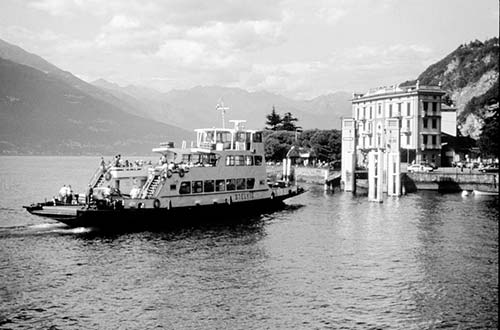
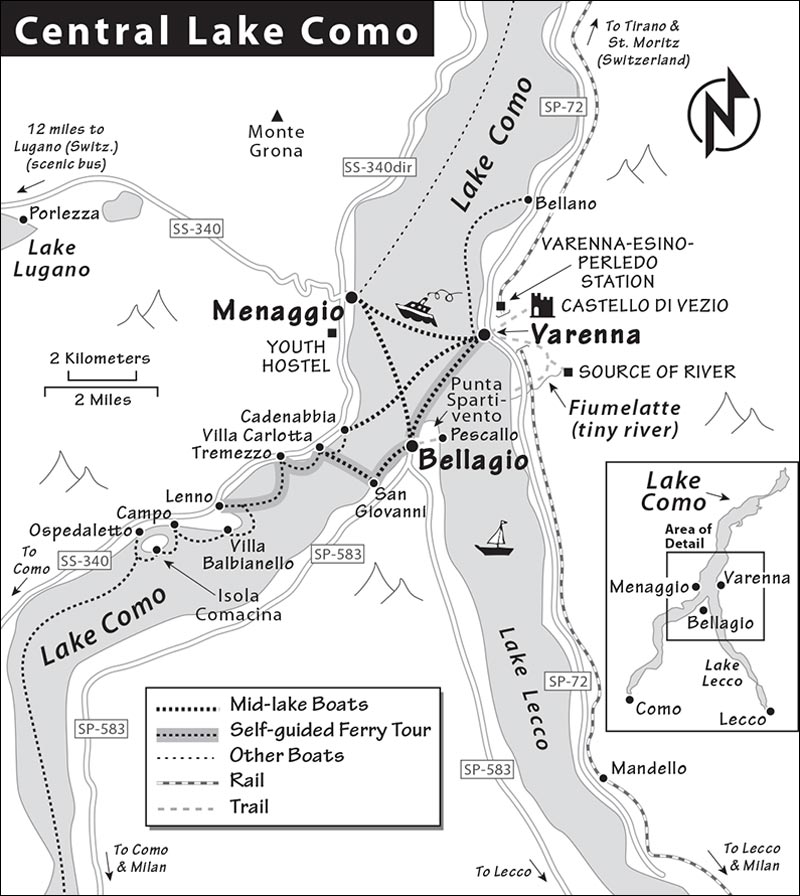
If you’re making more complex plans, pick up a free boat schedule and ask for help to decipher it. It’s a good idea to ask your hotelier to review your possible connections before you set out so you can pace your day smartly. You’ll find the schedule at hotels and boat docks. Confusingly, the schedule requires you to scan four different timetables to know all the departures; for key terms, see the sidebar.
By Car: With scarce parking, traffic jams, and expensive car ferries, Lake Como is no place to drive. While it’s possible to drive around the lake, it’s not a scenic loop: The road is narrow, congested, and lined with privacy-seeking walls, hedges, and tall fences. If you do have a car, park it in Varenna’s big underground garage, and use the boat to get around. Parking in Bellagio is more difficult than in Varenna.
While you can rent cars in Bellagio, for most travelers, it’s best to take the train to Milan and pick up a car there, either at the central train station or at one of Milan’s three airports.
This well-manicured village of 800 people offers the best of all lake worlds. Easily accessible by train, on the less-driven side of the lake, Varenna has a romantic promenade, a tiny harbor, steep and narrow stepped lanes, and some scenic sights (a ruined castle and two villas). It’s just the right place to savor a lakeside cappuccino or aperitivo. There’s wonderfully little to do here, and it’s very quiet at night...unless you’re here during one of the hundred-or-so annual American wedding parties. The passerella (lakeside promenade, well-lit and inviting after dark) is adorned with caryatid lovers pressing silently against each other in the shadows. Varenna is a popular destination with my readers and European vacationers—book well in advance for high season (May-Oct). From November to mid-March, Varenna practically shuts down: Hotels close for the winter, and restaurants and shops reduce their hours.
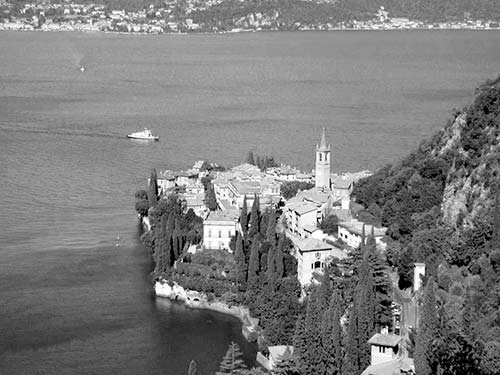
The TI is near the main square (Tue-Sun 10:00-13:00 & 14:00-18:00, closed Mon, shorter hours off-season, just past the bank at Via IV Novembre 7, tel. 0341-830-367, www.varennaturismo.com [URL inactive]). The Tivano travel agency, located in the train station, also operates as a TI (see “Helpful Hints”). At either TI (or your hotel), pick up a town map and lake info.
Varenna is small, and pretty much everything is within a 15-minute walk.
By Train: From Varenna’s train station, follow the blue-painted pedestrian lane down to the main road. If you’re heading for the ferry to Bellagio, go straight to the water and turn left; otherwise, turn left along the main road, Via Corrado Venini, and keep rolling uphill into town (a 15-minute walk from the station). If you have a bag with wheels, use the high road rather than the lakeside promenade, which ends in stairs and cobbles.
A taxi from the station costs about €10. Reliable Marco Barili (or his wife Nelly) can meet you at the train station if you know your exact arrival time. Look for a flashing sign with your name (tel. 0341-815-061, mobile 348-550-0787, taxi.varenna@tiscali.it).
By Boat: The boat dock is close to the train station and a 10-minute stroll north of Varenna’s main square and old town.
By Car: Don’t even try to park on the streets of Varenna; the few spots are mostly reserved for residents. The easiest parking option is the multilevel lot at the south end of town, across from the entrance to Villa Monastero (€2/hour 6:00-22:00, otherwise €1/hour, €20/24 hours).
Parking at Varenna’s train station is free overnight, but you’ll pay from 8:00 to 20:00 most of the year (€1.50/hour, €13/day, feed coins into meter in center of lot and put ticket on dashboard).
Travel Agency: Varenna’s travel agency, I Viaggi del Tivano, is conveniently located in the train station. In addition to acting as a TI, they sell train tickets and book planes and automobiles (daily 9:00-13:00 & 14:30-18:30; good place to pick up boat schedules, tel. 0341-814-009, www.tivanotours.com, helpful Gaia, Martina, Cristina, and Eleonora). They also offer baggage storage (€5/day), rent e-bikes (€15/2 hours, €30/day), and sell half-day and daylong sightseeing bus and boat tours (including day trips looping through Switzerland).
Train Tickets: The train station doesn’t have ticket windows. Buy tickets at the I Viaggi del Tivano travel agency there (see above). Don’t cut it too close, in case there’s a line. You can also buy tickets on the town square at the Barilott bar/tobacco shop, which is also a lively place to buy a panino and/or a glass of wine (daily 7:00-20:00, closed Sun Oct-April, next to Hotel Royal Victoria at Via IV Novembre 6, tel. 0341-815-045, Claudia and Fabrizio).
Laundry: Lavanderia Pensa Barbara can wash and dry your laundry in 24 hours with morning drop-off (priced by weight, no self-service, Mon-Fri 9:00-12:00 & 15:00-19:00, Sat 9:00-12:00, closed Sun, Via Venini 31, tel. 340-466-2977). A self-service machine is tucked in the back of the little “Il Bottaio” shopping gallery facing the harbor (you’ll pay for laundry plus a €1 entry voucher every time you go in/out, voucher covers WC or can be used toward food or drinks at nearby Bar il Molo, daily 8:00-24:00). Another self-service option is just off the main square, between the recommended Albergo del Sole and the post office (“change” machine dispenses only tokens, Bar Il Molo can break bills for you, daily 24 hours, Contrada del Prato 10).
Nightlife? None. Here your time is better spent taking a lakeside stroll and watching the moonlight dance on the water.

Since you came here to relax, this short self-guided walk gives you just the town basics.
• Begin by standing in the little piazza next to the...
Bridge Just Below Train Station: This main bridge spans the tiny Esino River, which divides two communities: Perledo (which sprawls up the hill—notice the church spire high above) and the old fishing town of Varenna (huddled around its harbor). The train station, called Varenna-Esino-Perledo, gives due respect to both, as well as to the village of Esino, eight miles higher in the hills.
Go down the tree-lined promenade on the right (north) side of the river. You’ll run into the entrance to the town’s public beach—the lido (small fee to enter)—and then cross the cute pedestrian bridge to the small square, which hosts a little market on Wednesday mornings.
The yellow inn facing the ferry dock, Hotel Olivedo, has greeted ferry travelers since the late 19th century and is named for the olive groves you can see growing halfway up the hill. Natives claim this is the farthest north that olives grow in Europe.
• Across from Hotel Olivedo is Varenna’s...
Ferry Landing: Since the coming of the train in 1892, this has been the main link to Milan and the world for the “mid-lake” communities of Bellagio, Menaggio, and Varenna. From this viewpoint, you can almost see how Lake Como is shaped like a man. The head is the north end (to the right, up by the Swiss Alps). Varenna is the left hip (to the east). Menaggio, across the lake, is the right hip (to the west). And Bellagio (hiding behind the smaller wooded hill to your left) is the crotch—or, more poetically, Punta Spartivento (“Point That Divides the Wind”). In a more colorful description, a traditional poem says, “Lake Como is a man, with Colico the head, Lecco and Como the feet, and Bellagio the testicles.” (In the regional dialect, this rhymes—ask a native to say it for you.)
Across the lake, the farthest high ridges mark the border of Switzerland. This region’s longtime poverty shaped the local character. Many still remember that the Varenna side of the lake was the poorest, because those on the Menaggio side controlled the lucrative cigarette-smuggling business over the Swiss border. Today, the entire region is thriving—thanks to tourism (and the many Italians who commute to jobs in Switzerland, across the border).
• Walk past the ferry dock, past the small playground, and check out the old traditional boat (on the left). This is an example of the standard lake utility and fishing boat. Men would stand to row (see the oarlocks). The frame supported a canopy—giving some shelter to fishermen who spent the night net fishing. Just beyond is Varenna’s elevated shoreline walk, called the...
Passerella: A generation ago, Varenna built this elegant lakeside promenade, which connects the ferry dock with the old town center. Strolling this lane, you’ll come to a tiny, two-dinghy, concrete breakwater of a villa. Lake Como is lined with swanky 19th-century villas; their front doors face the lake to welcome visitors arriving by boat. At this point, the modern passerella cuts between this villa’s water gate and its private harbor. Just around the bend, enjoy a good Varenna town view. These buildings are stringently protected by preservation laws; you can’t even change the color of your villa’s paint.
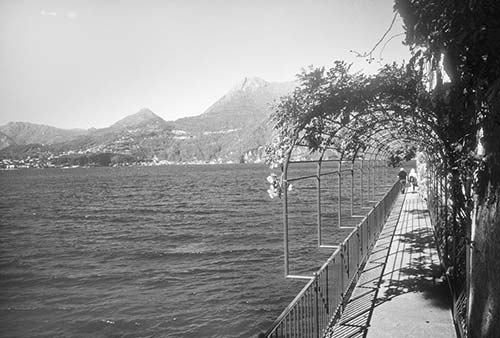
Just over the hump (which allows boats into a covered moorage), look back and up at another typical old villa—with a private passerella, a lovely veil of wisteria, and a prime lake-view terrace. Many of these villas are owned by the region’s “impoverished nobility.” Bred and raised not to work, eventually they were unable to pay for the upkeep of their sprawling houses. Some of these villas have now been bought by the region’s nouveau riche.
• At the community harbor, walk to the end of the pier for a town overview, then continue under the old-time arcades—with chestnut beams and a fishing heritage going back to the 1600s—toward the multihued homes facing the harbor.
Varenna Harborfront: There are no streets in the old town—just the characteristic stepped lanes called contrade. Varenna was originally a fishing community. Even today, old-timers enjoy Lake Como’s counterpart to Norwegian lutefisk: missoltino, air-dried and salted lake “sardines.”
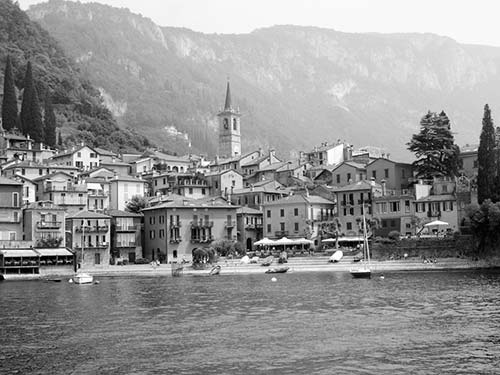
Imagine this harbor 200 years ago: The “Il Bottaio” gallery is named for the cooperage—once active with coopers fitting chestnut and oak staves into barrels. Stoneworkers were busy carving the black marble that was quarried just above town. Fishermen dragged boats onto the sloping beach and unloaded their goods onto carts for horses to carry up Contrada dei Cavalli (named for those horses, with gentler, more horse-friendly steps than other lanes) to the market square above. The little stone harbor dates from about 1600. Today, the fishing boats are just for recreation.
At the south end of the harbor, belly up to the banister of Bar il Molo’s upper terrace for a colorful town view. Another traditional ditty goes, “If you love Lake Como, you know Bellagio is the pearl...but Varenna is the diamond.”
• Continue straight, leaving the harbor. A lane curves around Hotel du Lac, where you can check out its fine lakeside terrace (it welcomes even nonguests for drinks—try the afternoon happy hour—and has an amazing view). Then climb the stairs (opposite the hotel) on a lane called Contrada Oscura to...
Piazza San Giorgio: Varenna’s town square, historically the market square, faces what for centuries has been the lakeside highway. In earlier eras it was busy with traders and pilgrims.
The sycamore, or plane, trees, groomed to provide shade, are planted to make a V for Varenna. The street plan survives from Roman times, when gutters flowed down to the lake. The little church on the lake side of the square is the baptistery. Dating from the ninth century, it’s one of the oldest churches on the lake (but rarely open).
The Hotel Royal Victoria, also on the main square, recalls the 1839 visit of Queen Victoria, who registered herself as the Countess of Clare in an attempt to remain anonymous.
Church of San Giorgio (Chiesa di San Giorgio): Varenna is an understandably popular spot for weddings—rice often litters the church’s front pavement. The main church was built in the 1200s. Imagine being a 13th-century wayfarer and coming upon the fresco of St. Christopher, patron saint of travelers, on the church’s facade. With a backpack—just like you—at his feet, he welcomes you to step inside.
You’ll find a Romanesque interior with a few humble, centuries-old bits of carving and frescoes. The black floor and chapels are made from local marble. On the right, a beautifully carved walnut confessional is ornamented with symbols reminding worshippers that in death, all are equal. And the fresco on the back wall, dating from the same century as Dante’s Inferno (the 14th), makes the horrors of hell all too clear.
• Leaving the church, turn left to find the TI and the Ornithology and Natural Science Museum, with a small collection of stuffed birds and other wildlife (small fee).
Lake and Garden View from Villa Monastero: Finish your walk a hundred yards farther down the street (past the Villa Cipressi). Across from the big parking garage, step through the door of the Villa Monastero (on the right) and up to the balcony overlooking the garden and the lake: Here you can savor an ultimate Lake Como view.
Lake Como is lined with aristocratic 19th-century villas. In the Romantic Age, a villa came with a charming lakeside kiosk and an extravagant garden. People loved exotic trees, and here—at the latitude of Boston—they could grow palms and oranges. A promenade through this mix of gardens and architecture was enjoyed as an art form.
Your tour is over, and now you have options. You can pay to explore the Villa Monastero gardens (described next page). You can catch the steep trail nearby up to the castle (also described next). Or you can return to the square and head downhill to enjoy the Varenna waterfront. Either of the lanes flanking the Hotel Royal Victoria go down to the humble beach, and farther along, lanes go to the café-lined harborfront.
A steep and stony trail leads to Varenna’s ruined hilltop castle, located in the peaceful, traffic-free, one-chapel hamlet of Vezio. It was built on the remains of an ancient Roman fort that was part of a defense system spanning the entire lake. In the sixth century, after the fall of Rome, the barbarian Longobards settled here and needed a fortress on this strategic spot. Today, the castle itself is barren—a courtyard protecting an empty tower, where you can cross a drawbridge and climb 60 steps to earn 360 degrees of Lake Como panoramas.
Cost and Hours: €4, Mon-Fri 10:00-18:00, Sat-Sun until 19:00, June-Aug stays open one hour later, March and Oct closes one hour earlier, closed Nov-Feb and in bad weather, mobile 333-448-5975, www.castellodivezio.it, Nicola.
Visiting the Castle: To get to the castle, hike up Via per Vezio, the small road near Hotel Montecodeno (figure on a 20-minute steep climb one-way). Arriving in Vezio, follow castello signs. You’ll reach a bar (with drinks, light food, and WCs) that serves as the castle’s ticket desk.
Once inside the grounds, the views are the main attraction: Follow the little loop trail on the lake side of the castle for vistas down on Varenna’s rooftops and the adjacent lakefront community of Pino.
The parklike terrace has birds of prey chained to little stakes (an owl, a buzzard, a hawk, and a falcon), each with a medieval name.
Falconry Shows: The castle hosts low-key falconry shows (by Nicola, free, for about an hour), usually around 15:00—but check the website or call in the morning for times.
Hiking Back Down: Leaving the castle grounds you’ll see a sign indicating two ways back to Varenna. You can hike back the way you came or make a loop by continuing down to the east end of Varenna, on a steeper, narrower, less-manicured trail. To do that, from the castle gate turn right and follow signs for Varenna Scabium and Sentiero del Viandante. You’ll wander past some backyards and some scenic tennis courts, then gradually descend, popping out at the parking garage for the Hotel Eremo Gaudio. From here, head down to the right to walk back into Varenna, passing the entrances for both Villa Cipressi and Villa Monastero (described next) on your way to the main square.
Two separate manicured lakeside gardens sit next door to each other just a short distance from Varenna’s main square. While the villas and gardens elsewhere on the lake are more magnificent (see “More Sights on Lake Como,” later), these are a good option if you’re staying around Varenna. An €11 combo-ticket covers the gardens at both villas but not the museum at Villa Monastero.
Villa Cipressi: First are the small but lush terraces of Villa Cipressi, which stretch to the nearby Hotel Royal Victoria. The gardens were principally built between 1400 and 1800, and have been carefully restored and embellished. The lakeside climate is amenable to species not otherwise common in northern Italy. Look for agaves, myrtles, and a rare California cypress (€6, €11 combo-ticket includes Villa Monastero gardens but not museum, garden brochure dryly details 56 different trees and shrubs, daily 8:00-sunset, closed Dec-April, www.hotelvillacipressi.it).
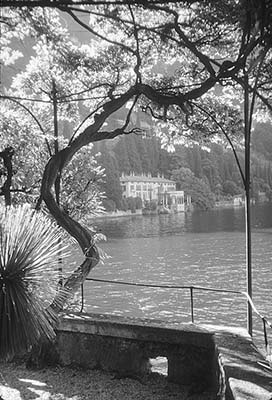
Villa Monastero: Just beyond are the more interesting grounds of Villa Monastero, which also admits visitors into the former residence of the De Marchi family, now a museum filled with overly ornate furnishings from the late 1800s. It offers the handiest look inside one of the old villas that line the lakeshore, but the lack of information makes the place feel sterile. The gardens feature cypress trees, several varieties of palms, a citrus garden, and a wisteria garden that is delightful when in bloom (gardens-€6, gardens and museum-€9; €11 combo-ticket covers gardens here and at Villa Cipressi but not museum; gardens open daily 9:30-19:00, closed Nov-Feb; museum open Fri-Sun 9:30-19:00, closed Mon-Thu except open daily in Aug; garden bar serves snacks, tel. 0341-295-450, www.villamonastero.eu).
There are three spots to swim in Varenna: the free little beach behind the Hotel Royal Victoria off Piazza San Giorgio, the central lakefront area by Nilus Bar, and the lido (best-equipped for swimmers). Just north of the ferry dock, it’s a wide concrete slab with sand and a swimming area off an old boat ramp. It has showers, bathrooms, a restaurant, a bar, and lounge chairs and umbrellas for rent (€3 entry, tel. 0341-815-3700). Swimming by the ferry dock is strictly forbidden for safety reasons.
You can explore the lake either by taking a boat tour with a captain who narrates the views as you skirt elegant villas and the homes of famous neighbors (1-3 hours, 6-10 people on a fast boat) or by renting your own boat (with a 40-hp engine). Renting a boat requires no license. It’s not realistic to stop anywhere, so you’ll just putter around the mid-lake region trying to stay out of the ferry’s path.
Taxi Boat Varenna organizes hour-long central-lake tours (€30/person), plus a 2.5-hour version that adds a stop at Villa Balbianello (€60/person, price includes villa entry and one-hour tour). They also offer hour-long romantic private tours (€180 for up to 6 people) and a three-hour tour. Book directly on the website (mid-March-mid-Nov only, mobile 389-949-9104, www.taxiboatvarenna.com). A similar company works out of Bellagio.
Nautica Varenna, for those who want to be their own skipper, rents motorboats (from €70/hour, up to 6 people) and zero-horsepower kayaks (€10/hour). You’ll find them at the harbor in front of the Nilus Bar (mobile 392-417-0347, www.varennaboatrental.com).
Varenna Rent a Boat is a more serious boat-rental shop with a fleet just beyond the ferry dock. Roberto’s a mechanic, so you know things are in good shape, and his boats come with GPS systems, so he always knows where you are (from €80/hour, mobile 338-140-7424, www.varennarentaboat.com).
Wayfarers’ Path: The best three-hour hike from Varenna is along the Wayfarers’ Path from Bellano to Varenna. Take the train (or boat) to Bellano and hike steeply up and then along the hill and back into Varenna on the well-marked trail. (Get details from your hotel or the TI.)
Fiumelatte: The town of Fiumelatte, about a half-mile south of Varenna, was named for its “milky river.” Promoted as the shortest river in Italy (at 800 feet), it runs—like the area’s tourist industry—only from April through September (though even then it may be dry, depending on the weather). The La Sorgente del Fiumelatte brochure, available at Varenna’s TI, lays out a walk from Varenna to the Fiumelatte, then to a castle, and back. It’s a 30-minute hike to the source (sorgente) of the river (at Varenna’s monastery—take the high road, drop into the tranquil and evocative cemetery, and climb steps to the wooded trail leading to the peaceful and refreshing cave from which the river spouts).
Central Lake Boat, Food, and Villas Tour: Lake Como Food Tours, run by creative team Laura and Elena, has a selection of guided activities. For a well-organized and very experiential day, consider their “Central Lake Boat, Food, and Villas Tour” (runs most mornings at 10:30 from Varenna). You’ll load into a van to visit an old mill for an olive oil tasting, take a guided walk through Varenna with an included lunch, hop in a boat for an hour-long tour of the lake, see Villa Balbianello with a local guide, and finish in Bellagio with a walk through the botanical gardens at Villa Melzi. This leaves you in Bellagio at about 17:00 free for the evening and a convenient ferry ride away from your Varenna starting point (€255, RS%—use code “ricksteves” for 15 percent discount on anything they offer, mobile 349-560-0603, www.lakecomofoodtours.com).
Charming chef Moreno of the recommended Ristorante il Caminetto picks you up in Varenna, zips you 10 minutes up the mountain to his restaurant, and then teaches you some basics of Italian cooking. Gathered around a big table with a dozen or so other English-speaking travelers, you’ll learn how to make fresh pasta and prep regional specialties. Classes cover three recipes and last about three hours, plus time to mangiare (€67 includes transfers from and back to Varenna, lesson, recipes, and lunch complete with wine, cookies, and coffee; Mon, Tue, Thu, and Fri; 10:00 pickup from Varenna ferry landing or parking garage, return by 16:00; reservations required, tel. 0341-815-127, www.ilcaminettoonline.com, info@ilcaminettoonline.com).
Reservations are tight in August, snug May through October, and wide open most of the rest of the year. Many places close in winter. High-season prices are listed here; prices get soft off-season.
$$$$ Hotel du Lac, filling a refined and modernized 19th-century villa, is classy and dignified. From its exclusive private perch on the point, it offers a quiet lakefront breakfast terrace; genteel public spaces; a friendly, professional staff; and 16 delightful rooms—all but three with lake views (air-con, some rooms with elevator access, pay parking, Via del Prestino 11, tel. 0341-830-238, www.albergodulac.com, info@albergodulac.com, Valleria).
$$$$ Villa Cipressi is a sprawling, centuries-old lakeside mansion with 31 rooms (some in a courtyard annex) that have a sophisticated simplicity. The villa sits in a huge, quiet, terraced garden that nonguests pay to see. Its elegant but understated public spaces are often busy with wedding parties. Guests can use their free shuttle service to and from the train station or ferry dock between 9:00 and 16:00 (RS%, some view rooms, family rooms, streetside rooms can be noisy, air-con, elevator in main building, pay parking, Via IV Novembre 22, tel. 0341-830-113, www.hotelvillacipressi.it, info@hotelvillacipressi.it).
$$$$ Hotel Royal Victoria, a central splurge facing the main square, has a classic, grand-hotel lobby, an inviting terrace with a swimming pool just above the lake, and 43 richly furnished rooms with modern amenities (RS%, some view rooms, air-con, elevator, pay parking, Piazza San Giorgio 2, tel. 0341-815-111, www.royalvictoria.com, info@royalvictoria.com).
$$$$ Villa Monti has six apartments (most with lake views, two with balconies) perched along Via Roma. Each is styled with a modern coziness, sleek kitchenette, and beautiful artwork. The pool is petite but has impeccable views and lots of deck chairs along a terraced garden (family rooms, air-con, no breakfast, check-in 14:00-18:00 or by appointment, Via Roma 11, tel. 0341-168-0161, www.visitvarenna.com, villamonti@vistivarenna.com).
$$$ Albergo Milano, right in the old town, is graciously run by Egidio and his Swiss wife, Bettina. Fusing the best of Italy with the best of Switzerland, this well-run, romantic hotel has eight comfortable rooms with extravagant views, balconies, and big terraces (ceiling fans, no elevator; from the station, take main road to town and turn right at steep alley where sidewalk and guardrail break; Via XX Settembre 35, tel. 0341-830-298, www.varenna.net, reservations@varenna.net). This place whispers luna di miele—honeymoon (see website for honeymoon deal). Nearby is $$$ Casa Rossa, an annex with five comfortable rooms and an apartment that works well for families (breakfast served at main hotel, nonview rooms are more budget-friendly). Their recommended Ristorante la Vista is worth considering for dinner.
$$$ Albergo del Sole rents eight simple, comfortable rooms (with partial-lake or piazza views) above a restaurant right on the town square, which can be lively at night. It’s run by fun-loving Enzo and Francesco (family rooms, air-con, hardwood floors, shiny bathrooms, elevator, open all year, Piazza San Giorgio 17, tel. 0341-815-218, www.solevarenna.altervista.org, albergo.sole@virgilio.it).
$$ Hotel Montecodeno, with 11 decent rooms and no views, is a functional concrete box along the main road, next to the northern trailhead to Vezio Castle. It’s a five-minute walk from the train station and ferries (RS%, air-con, no elevator, attached restaurant, Via Venini 146, tel. 0341-830-123, mobile 340-356-7688, www.hotelmontecodeno.com, info@hotelmontecodeno.com, Marco).
$ Albergo Beretta, on the main road a block below the station, has 10 small, basic rooms, several with balconies (and street noise). Second-floor rooms are quietest. Above a coffee shop that doubles as the reception, it feels dated and lacks lakeside glamour but is a decent budget option (elevator, pay parking nearby, Via per Esino 1, tel. 0341-830-132, hotelberetta@iol.it, Barbara).
Lavarello, a lake whitefish, is popular on menus. For something more adventurous, consider missoltino, which are salted little fish often served with pasta or local-style polenta (buckwheat is mixed in with the corn). Pizzocchere is a regional pasta dish made with buckwheat noodles, boiled potatoes, greens, and lots of melty cheese—a carb lover’s dream. As with Varenna’s hotels, many of these restaurants close off-season (generally November through February or March).
$$$$ Ristorante la Vista, at Albergo Milano, feels like a private hotel restaurant but also welcomes nonguests. On a balmy evening, its terrace overlooking the town and the lake is hard to beat. Egidio (or Egi—pronounced “edgy”) and his staff give traditional cuisine a creative twist, and his selection is great for foodies with discerning tastes. While you can order à la carte, I’d go with his €40 three-course fixed-price dinner (Mon and Wed-Sun 19:00-22:00, closed Tue; reservations required, Via XX Settembre 35, tel. 0341-830-298, www.varenna.net).
$$$ Ristorante il Cavatappi serves honest, unpretentious yet beautifully presented dishes grounded in classic Italian cuisine. It’s a classy little place on a quiet lane, with only seven tables, so the cook-and-waiter team can connect personally with diners. It’s both elegant and intimate with tight and convivial seating under a single vault and three tables outside on the stony lane. The chef is vegetarian, so there’s always a good veggie course (Thu-Tue 12:00-14:00 & 18:30-21:00, closed Wed, closed Oct-March, reserve for dinner, Via XX Settembre 10, tel. 0341-815-349, www.cavatappivarenna.it).
$$$ Osteria Quatro Pass is a welcoming bistro known for its homemade pasta, lake fish, and meat. It offers 18 candlelit tables under picturesque vaults, plus sidewalk seating. Its fun energy lets you know that it’s a popular spot (daily 12:00-14:00 & 18:30-22:00, closed Mon-Wed in winter, Via XX Settembre 20, tel. 0341-815-091, Chiara serves while her husband Giuseppe cooks).
$$$ Varenna Monamour’s split-level interior, done up with stone and beams, feels sleek but casual. Its menu has a nouvelle-cuisine flair, and the restaurant prides itself on specializing not in lake fish but in seafood (late May-Sept daily 12:00-15:00 & 18:00-23:30, shorter hours off-season, closed mid-Nov-Feb, Contrada Scoscesa 7, tel. 0341-814-016, www.varennamonamour.it).
$$$ Vecchia Varenna Ristorante, the only classy restaurant right on the water, is under the old stone arcade in the center of town. Its menu is creative, offers a fine value, and seems to taste even better if you sit on the terrace. Chef Luca takes no reservations (Tue-Sun 12:30-14:00 & 19:30-21:30, closed Mon, Contrada Scoscesa 14, tel. 0341-830-793).
$$$ Ristorante al Prato, tucked onto a quiet square a block off the harbor, does regional specialties and international dishes with local ingredients and influences. Chef Giulio’s joy of cooking shows through in the meals, and good-natured owner Giovanni enjoys interacting with the guests (daily 12:00-14:00 & 19:00-21:00, Piazza del Prato 6, mobile 348-712-4389).
Beautifully situated along the waterfront in Varenna’s old section are three simple eateries: Varenna Caffè Bistrot, Bar il Molo, and Nilus Bar. All are crowd-pleasers for their great lakefront seating and ideal for lingering over affordable food in a stunning setting. Each serves salads, sandwiches, pizzas, and pastas for around €10 and cocktails between meals. All are open daily; Il Molo and Varenna Caffè Bistrot are also open at 9:00 for breakfast. While Il Molo and Nilus have nicer terraces, the food at Varenna Caffè Bistrot is a bit more serious.
$$ Ristorante del Sole is an old-school place facing the town square that feels like it was here before tourism. It serves respectable, well-priced meals and Neapolitan-style pizzas. This family-friendly restaurant provides a fun atmosphere, a cozy, walled-in garden in back, and tables on the square. Try their hearty pizzocchere, a handmade buckwheat pasta with melted cheese, potatoes, and greens (daily 11:00-16:00 & 18:30-late, Piazza San Giorgio 17, tel. 0341-815-218, www.solevarenna.altervista.org; Francesco and Enzo).
High Above Town: $$$ Ristorante il Caminetto is a homey, backwoods mountain trattoria in Gittana, a tiny town in the hills above Varenna. Getting there entails a curvy 10-minute drive (they’ll pick you up for free at 19:00 or 19:30 at the ferry dock or the parking garage and bring you home after dinner). Moreno and Rossella take pride in their specialties, including grilled meats and risotto with porcini mushrooms and berries. They serve 22 diners a night and that’s it. Plan on the €32 three-course fixed-price meal and spending the evening—you won’t regret it (open Thu-Tue 19:30-21:30, Sat-Sun also 12:30-14:30, closed Wed, reservations mandatory to confirm pickup from Varenna, Viale Progresso 4, tel. 0341-815-127, mobile 347-331-2238, www.ilcaminettoonline.com).
By the Ferry Dock: $$ Pub l’Orso, filling a renovated former joiner’s workshop, is a fun bar that serves cheap salads and sandwiches (at the ferry dock, behind Hotel Olivedo). $$$ Hotel Olivedo, a fine old hotel facing the ferry dock, serves diners in a classic Grand Tour hall.
Gelato: Side-by-side places on the harborfront compete with good gelato and pillows on the adjacent stone steps. At Gelateria Riva, Duilio prepares his gelato fresh every day (ask the day before if you want to watch it being made). Try his nocciola (hazelnut) before making your choice (daily 11:00-19:00, later in summer). A few doors down, Giulia at La Passerella makes tasty gelato, as well as refreshing fruit sorbets. Also on the menu is an enticing array of pastries and sweets (daily 10:00-20:00, later in summer).
Scenic Aperitivo: The Hotel du Lac has the most beautiful lakeside setting in town. Anyone is welcome to enjoy its garden or terrace, which literally hangs over the lake, for a happy hour aperitivo (daily 15:00-20:00). An €8 spritz or glass of wine comes with a plate of meat and cheese. They also have wine tasting on the menu.
Picnics: Varenna’s two little grocery stores have all you need for a tasty balcony or breakwater picnic. The salumeria on the main square is best for meats, cheese, and bread; try their homemade salami (Tue-Sat 8:30-12:30 & 16:00-19:30, Sun-Mon 8:30-12:30 only, Via IV Novembre 2). The grocery store just north of the main square by the pharmacy stocks fresh fruits, veggies, and a few essentials (Tue-Sat 8:30-19:00, Sun-Mon until 12:30, shorter hours off-season, Via Venini 6).
At the Train Station: $ Café III Binario is both charming and classy, offering fresh salads, homemade pizza, sandwiches, pasta, pastries, and even breakfast. Enjoy your food on their terrace or take it to go (daily 6:00-21:00, closes earlier off-season).
Breakfast in Varenna: For a leisurly start to your day on the lakefront, Varenna Caffè Bistrot and Bar il Molo each have a breakfast menu. (They get up and running at about 9:00.) Hotel Royal Victoria and Hotel du Lac offer buffet breakfasts with eye-popping views to nonguests for about €20 (check with reception that morning for availability). If you’re catching an early train, Café III Binario offers a good breakfast right at the station. To feel as though you’re staying in a boutique guesthouse (with an amazing view terrace overlooking the lake), break your fast at Albergo Milano, which offers visitors the same fine breakfast it serves its guests for €15 (reserve the night before).
Before leaving Varenna, buy your tickets from the I Viaggi del Tivano travel agency in the station. (Or, to avoid lines and stress at the station, buy tickets in advance in the town center at the Barilott bar/tobacco shop just off the main square.) Stamp your ticket in the yellow machine at the station before boarding. If the office is closed and you can’t buy tickets, win the sympathy of the conductor and buy your ticket as soon as you get on board for a small additional fee. (Find him before he finds you—or you’ll face a €50 fine.)
Varenna to Milan: Trains from Varenna to Milano Centrale take about an hour and leave at :37 past most hours (confirm schedule at the station or online at www.trenitalia.com). Additional connections require a change in Lecco and an extra 30 minutes.
Varenna to Stresa (on Lake Maggiore): You’ll have to take the train back to Milano Centrale, then connect from there to Stresa (3-4 hours).
Varenna to Lugano (Switzerland): Catch the ferry to Menaggio and then the bus (about hourly, 1 hour, €6). It’s a 10-minute walk into town from the ferry dock and then a bit confusing (buy bus tickets in front of the main church at the La Provincia bar; the bus stop is 100 yards uphill from there).
Varenna to St. Moritz (Switzerland): Take the train from Varenna to Tirano (1.5 hours), where you’ll have a layover before boarding the scenic Bernina Express train to St. Moritz (another 2.5 hours, 3 connections/day in summer, 1/day late Oct-early May, www.rhb.ch). A quicker, more frequent, but less scenic route is to take the train to Chiavenna (changing in Colico), then transfer to the bus, which takes you over the Maloja Pass to St. Moritz (5-6/day, 3.5 hours total). For times and tickets, stop by the I Viaggi del Tivano travel agency (see “Helpful Hints,” earlier). Don’t forget your passport for trips into Switzerland. For more about St. Moritz and scenic trains, consider my guidebook Rick Steves Switzerland.
The self-proclaimed “Pearl of the Lake” is a classy combination of tidiness and Old World elegance. If you don’t mind that “tramp in a palace” feeling, it’s a fine place to shop for ties and umbrellas while surrounding yourself with the more adventurous posh travelers. Heavy curtains between the harborfront arcades create welcome shade and keep visitors and their poodles from sweating. Thriving yet still cute, Bellagio is a much more substantial town than Varenna.
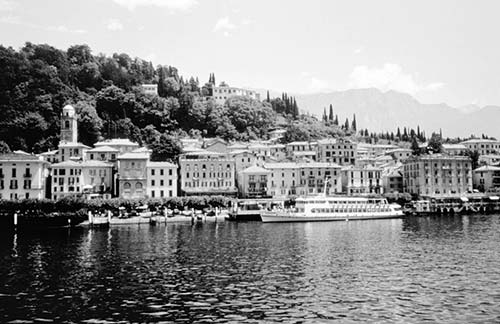
The TI is at the slow boat/hydrofoil dock (daily 9:30-17:30, shorter hours Nov-March, tel. 031-950-204, www.bellagiolakecomo.com). The TI has free brochures for several walking tours, varying from one to three hours. They also sell a hiking map that shows hikes with a range of difficulty and duration.
Bellagio is best reached by boat from Varenna or Como.
By Boat: Bellagio has two docks a couple hundred yards apart. One serves slow boats and hydrofoils; the other is for faster car ferries. When you depart, be sure you’re at the right dock—ask when you buy your ticket. For details on boat schedules, see “Getting Around Lake Como” near the beginning of this chapter.
By Car: Having a car in Bellagio makes little sense. Parking is difficult and the center of town is a no-traffic ”ZTL” zone 10:00-18:30—pay attention to signed restrictions. Spaces marked with white lines are always free, yellow lines are for residents only, and blue lines are pay-to-park (use pay-and-display machines—€1.50/hour 8:00-23:00, free overnight). Looking for a free spot is likely a waste of time and energy. Plan on just paying and displaying.
Laundry: Lavanderia Vecchia is handy. Don’t be discouraged if it looks closed; the lights come on automatically when you enter (daily 8:00-23:00, Salita Carlo Grandi 21, mobile 333-659-9074). You can pass the time at the fun Angelo DiVino wine bar across the way.
Bellagio to Como by Bus: An hourly bus runs from the Como train station to Bellagio. In Bellagio, buy tickets at Bar Sanremo (midway between the two docks, facing the water at Via Lungo Lario Manzoni 40) or pay more from the driver.

Bellagio was built below a medieval fortress that capped its hill (today’s Villa Serbelloni Park). The town’s chic image was stoked by the Rockefellers (who purchased Villa Serbelloni in 1927) and by John F. Kennedy (who visited in 1961).
The harborfront is mostly fancy shops and cafés designed for visitors. Café Rossi, with a 1905 interior, faces the ferry dock. While Johnnie Walker and jewelry sell best at lake level, the natives shop up the hill.
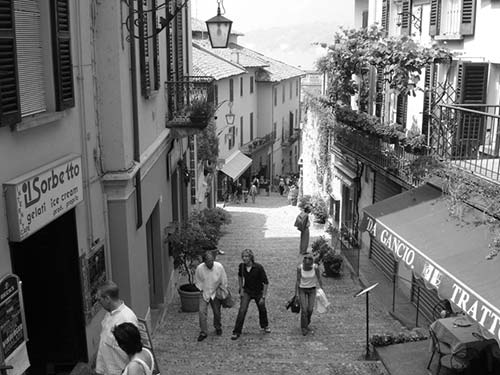
Explore the steep-stepped lanes rising from the harborfront. Piazza della Chiesa, near the top of town, has an 11th-century church that’s worth a look. It’s dedicated to Saint James and has a dark, typically Romanesque interior with small windows, a marble pulpit carved with symbols of the four evangelists, and a golden altarpiece under glittering mosaics (pick up the English handout that describes its art).
North of Town: The de facto capital of the mid-lake region, Bellagio is located where the two legs of the lake split off to the south. For an easy break in a park with a great view, wander right on out to the crotch. Meander behind the rich-and-famous Hotel Villa Serbelloni, and walk 10 minutes up a concrete alley to Punta Spartivento (“Point That Divides the Wind”). You’ll pop out to find a Renoir atmosphere complete with an inviting bar-restaurant (see “Eating in Bellagio,” later), a tiny harbor, and a chance to sit on a park bench and gaze north past Menaggio, Varenna, and the end of the lake to the Swiss Alps.
South of Town: For another stroll, head south from the car-ferry dock down the tree-shaded promenade. Ten minutes later, you’ll pass the town’s “beach.” The Lido di Bellagio is actually a terrace with sand and rentable lounge chairs, a youthful cocktail bar, a concrete pool, and a swimming platform in the lake. Just beyond the lido is Villa Melzi Gardens (€6.50, daily 9:30-18:30). While the actual villa is not open to the public, the gardens are, and visitors enjoy a long and lovely lakeside promenade with exotic plants, flowers, and trees (all labeled—pick up the botanical guide at the entry) and Neoclassical sculpture that was assembled by the vice president of Napoleon’s Italian Republic in the early 19th century. Although not as elaborate as some of the lake’s finer gardens, it offers a pleasant, tree-shaded lakefront stroll. Gaze across the lake at the Villa Carlotta (straight over, surrounded by greenery—described later, under “More Sights on Lake Como”) and imagine the time when aristocrats tried to outdo each other (and showcase their wealth) by creating unique and immense horticulture collections.
At the far end of the garden you can exit at the tiny harbor of Loppia, where you’ll be tempted by the recommended Alle Darsene di Loppia restaurant. About 15 minutes farther south, you’ll reach San Giovanni, with a pebbly public beach (no showers).
If you need a destination, you can visit this park (accessible only with guided tour), which overlooks the town. The villa itself, owned by the Rockefeller Foundation, is not open to the public.
Cost and Hours: €9, required tour Tue-Sun at 11:00 and 15:30; no tours Mon, Nov-mid-March, or when rainy; 1.5 hours, first two-thirds of walk is uphill, show up at the little tour office in the medieval tower on Piazza della Chiesa 15 minutes before tour time to buy tickets, confirm time at office, tel. 031-951-555.
Bellagio Water Limousines, with a small stand adjacent to the slow boat/hydrofoil dock, is run by Australian Jennine and Italian Luca, who offer tours and private service in their shiny mahogany Venetian water taxi. Consider their one-hour mid-lake tour (€40, most days) or their 2.5-hour mid-lake tour with a stop at Villa del Balbianello (€60, RS%, check blackboard for day’s offerings or call mobile 338-524-4914, www.bellagiowaterlimousines.com, bellagiowaterlimousines@gmail.com).
Bellagio Water Sports is where Michele offers two-hour kayaking tours (€40, most days at 10:00, weather dependent). He’s a 15-minute hike over a hill and down on Pescallo Bay near Hotel la Pergola at Via Sfondrati 1, mobile 340-394-9375, www.bellagiowatersports.com, info@bellagiowatersports.com).
This is a “boom or bust” lake resort, with high-season prices straight through from May to September, plus a brief shoulder season (with discounted prices) in April and from October to November. Bellagio closes down almost completely from December to February and is only half-open in March.
$$$$ Hotel Florence has a prime lakefront setting in the center of town. The 160-year-old place, run by the German Ketzlar family, features 30 rooms, hardwood floors, bold earth tones with splashes of bright colors, and a rich touch of Old World elegance (RS%, some rooms with view and balcony, air-con, elevator, Piazza Mazzini 46, tel. 031-950-342, www.hotelflorencebellagio.it, info@hotelflorencebellagio.it).
$$$ Hotel Metropole, dominating Bellagio’s waterfront between the ferry docks, is a grand old place with plush public spaces. Its tranquil rooms have classic flair and all the comforts. All 42 rooms have lake views, either side or full (family rooms, air-con, elevator, enormous roof terrace, Piazza Mazzini 1, tel. 031-950-409, www.albergometropole.it, info@albergometropole.it).
$$ Hotel Centrale, managed with pride and care by Giacomo Borelli, warmly welcomes its guests into a true-blue family operation: Signore Borelli’s two sons help out, his mama painted the art, and grandpa crafted much of the Art Deco-era furniture. Look for old family photos near the stairwell. The 17 bright, comfortable rooms lack views, but the public spaces are generous, including the balcony terrace (air-con, elevator, Salita Plinio 7, tel. 031-951-940, www.hc-bellagio.com, info@hc-bellagio.com).
$$ Albergo Europa, run with low energy by a kindly family, is in a concrete annex behind a restaurant, away from the waterfront. Its nine basic rooms (most with balcony) are harmlessly behind the times but get the job done (no elevator, free reserved parking, Via Roma 21, tel. 031-950-471, info@hoteleuropabellagio.it, Marchesi family).
$$ Il Borgo Apartments offers seven efficient, spacious units in the old center. Equipped with kitchenettes, these are a great deal for families or small groups. Easygoing Flavio and Silvia are available for check-in daily 11:00-14:00 or by appointment (RS%, cash preferred, no breakfast, air-con, elevator, Salita Plinio 4, tel. 031-952-497, mobile 338-193-5559, www.borgoresidence.it, info@borgoresidence.it).
$$ Albergo Giardinetto has 10 simply furnished rooms, barren hallways, and no breakfast, but guests may picnic in the large garden. Most rooms have lake and mountain views. Mother Laura and daughter Chiara (who speaks beautiful English) run the place with gentleness and gratefully welcome guests (air-con, no elevator, closed Oct-April, Via Roncati 12, tel. 031-950-168, www.albergogiardinetto.com, giardinetto@aol.it).
$$ Hotel Bellagio is stylish but unpretentious, with 28 airy rooms and parquet floors (some with balconies, most with views). The rooftop deck has sun chairs, and the basement gym is small but mighty (air-con, elevator, pay parking, Salita Grandi 6, tel. 031-952-202, www.hotelbellagio.it, info@hotelbellagio.it).
As with Bellagio’s hotels, many of these restaurants close off-season (generally December through February or March). Two places associated with hotels serve food on the lakefront in the town center (the Florence and Hotel Metropole’s Terrazzo Ristorante). The service won’t make you smile, and the price will dent your wallet. But the setting will be unforgettable. Rather than eat on the lakefront, I’d hang out there with a drink and find a better-value restaurant at a higher altitude.
$$ Trattoria San Giacomo is a high-energy place with traditional North Italian cuisine, such as riso e filetto di pesce (rice and perch fillet in butter and sage). It has seasonal specials and inviting €28 fixed-price meals (meat or fish) based on regional specialties. It offers fun seating on a steep, cobbled lane or tight seating inside (Wed-Mon 12:00-14:30 & 19:00-21:30, closed Tue, Salita Serbelloni 45, tel. 031-950-329, www.trattoriabellagio.it).
$$ Bilacus Ristorante, across the street, has a brighter, more open dining room, a fine garden terrace, an emphasis on wine (including some top-quality vintages by the glass), and a menu of traditional Italian dishes (Tue-Sun 11:30-15:00 & 18:30-22:00, closed Mon, Salita Serbelloni 32, tel. 031-950-480, www.bilacusbellagio.it). Aurelio is happy to give those with this book a complimentary vin santo and biscotti for dessert.
$$$ Ristorante Terrazza Barchetta, set on a terrace with no lake view and bedecked with summery colors, puts a creative twist on regional favorites such as lake fish, but is a little pricey (Wed-Sun 12:00-14:30 & 19:00-22:15, closed Tue, Salita Mella 13, tel. 031-951-389, www.ristorantebarchetta.com). Its simpler and less expensive sister, Terrazza Barchetta, is downstairs (described below).
You’ll find these places a short climb above the harbor.
$$ Ristorante Terrazza Barchetta is popular for its fun and accessible menu of quality, fairly priced pizza and pasta, and simple indoor and outdoor seating (daily 12:00-22:00, Salita Mella 13, tel. 031-951-389).
$$ La Fontana Ristorante Pizzeria, near the top of the old center, serves classic Italian dishes at a great price. It has a tight interior with the ambience of a cafeteria, and a nice terrace (go up Salita Monastero to Via Centrale 7, 031-950-283).
$$ Antichi Sapori, next door, is another good budget alternative—a favorite for salads, pizza, and pasta with a warm and cozy interior and a fine terrace (daily 11:30-22:00, Via Centrale 5, tel. 031-950-431, Julia and Nico).
$$$$ Alle Darsene di Loppia, the kind of place you’d expect jet-setters to dress up for, is a romantic gourmet restaurant serving Mediterranean cuisine with a Michelin rating. Consider their seared scallops and their tasting menu. It’s a 15-minute walk south of town (through the exquisite Villa Melzi Gardens—worth paying for if dining here to avoid the walk along the street). While seating indoors is OK, dining out on a historic little harbor under their pergolato is more memorable (Tue-Sun 12:00-14:30 & 19:00-21:30, closed Mon, on the far side of the Villa Melzi Gardens at Via Melzi D’Eril in Loppia, tel. 031-952-069, www.ristorantedarsenediloppia.com).
Dining North of Town: $$$ La Punta Ristorante is a good bet for a lakeside meal a 10-minute walk north at the dramatic Punta Spartivento. Set in a peaceful park, this family-run, white-tablecloth place has reasonable prices and very fresh fish (daily 12:00-22:00, tel. 031-951-888, www.ristorantelapunta.it).
Breakfast: If your hotel or B&B doesn’t provide breakfast, consider these options. Clustered near Piazza della Chiesa are several cafés that offer either full breakfast menus or à la carte options at tourist pricing: Pick from Torre del Borgo, Vecchio Borgo, and Daisy’s Bar. Down the street at Albergo Europa’s restaurant, you’ll find a good-value breakfast for €8.50. Hotel Metropole serves a €15 buffet breakfast and waterfront views to nonguests (reserve the night before). For a more reasonably priced buffet breakfast with a view (€8), walk-ins are welcome at Hotel Bellagio.
Wine Tasting: $$ Enoteca Cava Turacciolo is a classy-for-a-troll vaulted stone cellar wine bar. This fun-loving place run by Norberto and Rosy is great for a last drink before catching your ferry, or a simple meat-cheese-wine meal. They offer my readers a €19 taste of three regional wines with a sampling of cheeses, meats, and breads (Thu-Tue 11:00-24:00, closed Wed, Salita Genazzini 3, tel. 031-950-975, www.cavaturacciolo.it).
$$ Aperitivo Et Al, slick and jazzy, is a trendier wine bar; it also offers mixed salumi and formaggi plates and light lunches paired with the right wine. Andrea serves a great selection of wines by the glass (daily 11:30-24:00, Salita Serbelloni 34, tel. 031-951-523).
Gelato: Residents agree that you won’t find the best gelateria in town among the sundaes served on the waterfront. Instead, climb to the top of town to Gelateria del Borgo (daily 10:00-20:00, longer hours July-Aug, Via Garibaldi 46, tel. 031-950-755, Stefania and Gianfranco).
Picnics: You’ll find benches at the park, along the waterfront in town, lining the promenade south of town, and a 10-minute walk north in the lovely park at the tip of the peninsula (Punta Spartivento). Butti Macelleria e Salumeria, on the upper street near the gelateria, makes sandwiches and sells a few prepared foods (Tue-Sun 8:00-13:00 & 16:00-19:00, closed Mon, Via Garibaldi 42, tel. 031-950-333).
For the best one-day look at Lake Como, take my self-guided ferry tour to get your bearings, and hop off at the towns and villas of your choice. The two main villas worth considering (described after the tour) are Villa Carlotta—with a sterile, museum-like interior and gorgeous, sprawling gardens—and Villa del Balbianello, a bit harder to reach but with a more striking setting, gardens that are more architectural than botanical, and a fascinating tour of the lived-in interior. If you have time, visit both—they’re complementary. In this section, I also describe two other lake towns—Menaggio and Como—plus how to side-trip to Lugano in Switzerland.
The best simple day out is to take the battello navetta (mid-lake ferry) on its entire 50-minute Varenna-Bellagio-Villa Carlotta-Tremezzo-Lenno route (€9.20 without stops, or buy the €15 one-day pass and make it hop-on, hop-off; generally departs Varenna at 9:23, 10:23, 11:32, 12:13, 15:23, 16:25, and 17:33, confirm times locally; for more information, see here). On the return trip, hop off at any sights that interest you: Lenno (to see Villa del Balbianello), Villa Carlotta, and/or Bellagio. This commentary describes what you’ll see along the way, leaving from Varenna, though it’s doable from Bellagio too.
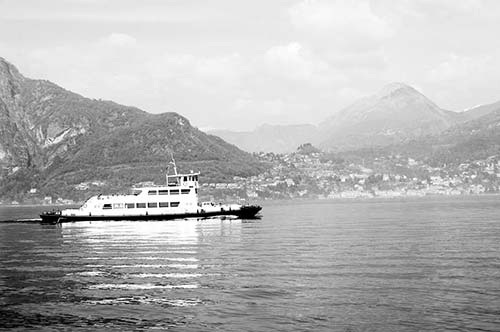
Leaving Varenna: Looking back at Varenna from the lake, you’ll see Vezio Castle rising above the town, with new Varenna on the left (bigger buildings and modern ferry dock) and old Varenna on the right (tighter, more colorful buildings). The big development high on the hillside is an ugly example of cronyism (without the mayor involved, this would never have happened). Under the castle is a grove of olives—reputedly the northernmost ones grown in Italy. Because the lake is protected from the north wind, exotic flowers grow well in the lake’s many fine gardens. To the right of Varenna’s castle are the town cemetery, a lift up to Hotel Eremo Gaudio (a former hermitage), and a spurt of water gushing out of the mountain just above lake level. This is the tiny Fiumelatte, Italy’s shortest river.
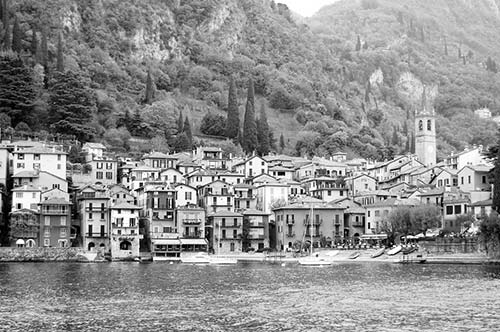
• On your way across to Bellagio, take a look around.
Mid-Lake: The Swiss Alps rise to the north. Directly across the lake from Varenna is Menaggio, and just over the ridge from there are Lugano and the “Swiss Riviera.” The winds alternate between north and south. In preindustrial times, traders harnessed the wind to sail up and down the lake. Notice the V-shaped, fjord-like terrain. Lake Como is glacier-cut. And, at more than 1,200 feet deep, it’s Europe’s deepest lake. You’ll cruise past the Punta Spartivento, the bulbous point that literally “splits the wind” and where the two “legs” of the lake join (Lake Lecco is on the left/east, and Lake Como on the right).
• Before long, you’ll be...
Approaching Bellagio: Survey the park at Punta Spartivento—it’s a pleasant walk from town. Bellagio has three times the number of hotel rooms as Varenna, as you can see upon approach. The town, with its strip of swanky hotels, is bookended by Grand Hotel Villa Serbelloni (five stars) on the left, dominating the lakefront, and the sprawling Grand Hotel Bretagne (four stars) on the right. In the 19th century, aristocratic Russians hung out in the Serbelloni, and well-heeled English chose the Bretagne. These days, the Serbelloni is the second-most luxurious hotel on the lake after Villa d’Este, while Bretagne is mired in a long renovation project.
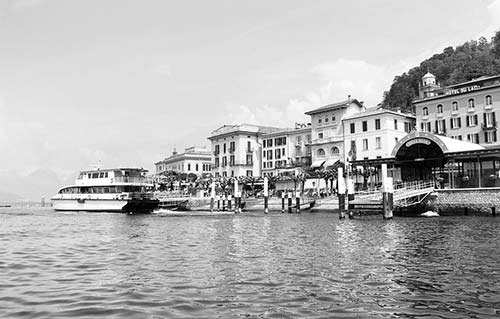
• Leaving Bellagio, you’ll pass Villa Melzi and its gardens, then the tiny harbor at Loppia. About half the boats make a stop at San Giovanni, a small, nondescript lakefront community just down the shore from Bellagio. Whether your boat stops here or not, soon you’ll head across the lake for a stop at...
Villa Carlotta: Because of lake taxes and high maintenance costs, owners of once-elite villas have been forced to turn them into hotels or to open their doors to the paying public. Since 1927, this has been an example of the latter. One of the finest properties on the lake, Villa Carlotta has some good Neoclassical sculpture (including works by Canova) and one of the lake’s lushest gardens (see listing below).
• The shortest hop on this route (you could walk it in less than 10 minutes) takes you along to the town of...
Tremezzo: As you leave the dock at Villa Carlotta, notice the Grand Hotel Tremezzo, with its striking Liberty Style (Art Nouveau) facade and swimming pool floating on the lake. Above the town is a villa built in the 19th-century Romantic Age to resemble a medieval castle (next to the stub of a real one).
After the Tremezzo stop—and just before the Tremezzo church—you’ll see a public park with a fountain and balustrade. When the road separated this land from its villa, its owners gave it to the community. Here the lake is dotted by a string of old villas with elegant landings and gated boathouses. Built in the days before motors, they are now too small for most modern lake boats.
Lenno: This pleasant resort town—with a long, arcing bay sheltering lots of little docks, and a generously shaded promenade—is the boat’s last stop.
It’s decision time: To see the recommended Villa del Balbianello, hop off here and turn to the next page. Return boats depart hourly; check the schedule before you set off. If you’d prefer to sail back to Villa Carlotta, Bellagio, or Varenna, you can probably stay put—this is the end of the line, so the boat’s going to turn around and head back that way (but for some departures, you may be evicted and need to wait for the next boat).
For gardens and flowers (its forte), this is the best of Lake Como’s famed villas—especially in spring, when the many flowers are in bloom. For gardeners, it’s worth ▲▲▲. I see the lakes as a break from Italy’s art, but if you need a culture fix, Villa Carlotta also offers an elegant Neoclassical interior with a sculpture gallery, including works by Antonio Canova.
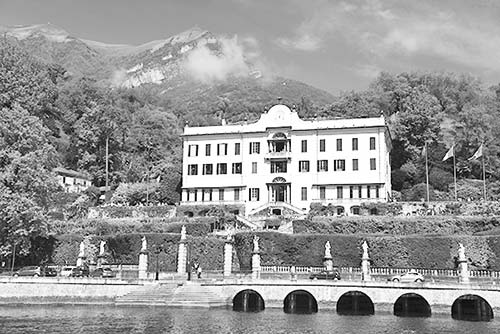
Cost and Hours: €10 includes villa/museum and gardens, daily 9:00-19:30, last ticket sold at 18:30, museum closes at 19:00, shorter hours last 2 weeks of March and Oct, closed Nov-mid-March, tel. 034-440-405, www.villacarlotta.it.
Getting There: Villa Carlotta, at the southern end of the town of Tremezzo, has its own ferry dock (served by the battello passenger ferries). It’s also less than a 10-minute walk from the Tremezzo and Cadenabbia docks (each served by a variety of boats). In a pinch, you can also use bus #C10 to zip along the lakefront to Lenno, near Villa del Balbianello (1-2/hour, pay driver, bus stop to the right as you exit Villa Carlotta).
Visiting the Villa: When buying your ticket, pick up the map that identifies the rooms in the house and the major plant groups in the gardens.
From the entrance, hike up the grand staircase and enter the villa itself. The main floor is filled with Neoclassical sculpture, including Antonio Canova’s Maddalena Penitente and Palamede and works by his students (look for the impressive replica of Canova’s famous Love and Psyche Reclining). There are also pieces by the great Danish sculptor Bertel Thorvaldsen. On the next floor up are generally well-presented special exhibits, and on the top floor are painstakingly appointed period rooms with elegant Empire Style (early-19th-century French) furniture.
Then explore the main attraction, the gardens, which sprawl in both directions from the villa. To the south (toward Tremezzo) is the classical Old Garden. To the north, things get more interesting: pretty camellias, luscious azaleas, a maze of rhododendrons, a bamboo garden, and the gasp-worthy Valley of the Ferns—a lush jungle gorge with a river coursing through it.
The dreamiest villa on the lake perches on a romantic promontory near Lenno, overlooking Lake Como and facing Bellagio. Built at the end of the 18th century on the remains of an old Franciscan church, today the villa reflects the exotic vision of its last owner, explorer and mountaineer Guido Monzino, who died in 1988—leaving his villa and everything in it to the state. It’s well worth paying extra to tour the interior to get to know Monzino, who led the first Italian expedition to climb Mount Everest in 1973. But the real masterpiece here is the terraced garden and elegant loggia, where the land fits the architecture and landscaping in a lovely way. This is a favorite choice for movie directors when they need a far-out villa to feature; this is where James Bond recovered from a particularly bruising experience in Casino Royale, and where Anakin first kissed Padmé (and later married her) in Star Wars: Episode II—Attack of the Clones.
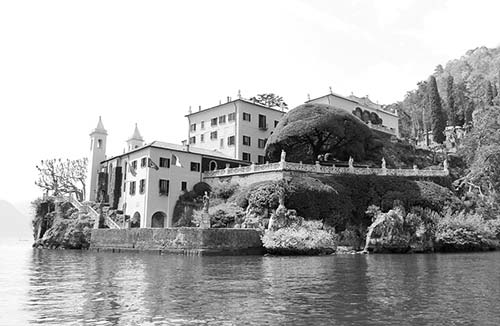
Cost and Hours: Garden only—€10, garden with villa tour—€20, Thu-Sun and Tue 10:00-18:00, closed Mon and Wed and mid-Nov-mid-March, last entry to garden 45 minutes before closing, tel. 034-456-110, www.visitfai.it/villadelbalbianello.
Tours: The only way inside the villa is with an English tour. Limited to 15 people per tour, these depart at least hourly (more frequently with demand); the first tour is usually at 11:00 and the last at 16:30.
Getting There: It’s at the end of a hilly point next to the town of Lenno. From the Lenno ferry dock, turn left and stroll around to the far end of the harbor (about 10 minutes). Here, you can either pay for a speedboat shuttle (€5 one-way, €7 round-trip, 2/hour, mobile 333-410-3854, www.taxiboat.net) or carry on by foot. If you choose to walk, continue past the boat dock and through the gate marked Villa Balbianello, where two options are clearly signposted in kilometers: a 20-minute, 1-kilometer (half-mile) hike (including some up and down), or a more challenging 45-minute, 2.5-kilometer (about 1 mile) huff over the top.
Visiting the Villa: Your visit includes two parts: the villa and the gardens. If walking from the boat and back (taking the shorter 20-minute path), allow a leisurely three hours total for the walk and garden/villa visit.
Poke around the gardens while waiting for your villa tour to begin. On the Bellagio-facing side, you’ll find a tranquil terrace with sweeping lake views. Along the path, notice the circular stone shed. Originally used for refrigeration (they used ice from the mountains to keep things cool), today this shed houses the tomb of Guido Monzino. On the opposite side of the point, you’ll find a terrace in front of the original Franciscan church (now a gift shop selling overpriced drinks). A WC is nearby, and just down the steps is the dock for the speedboat return to Lenno.
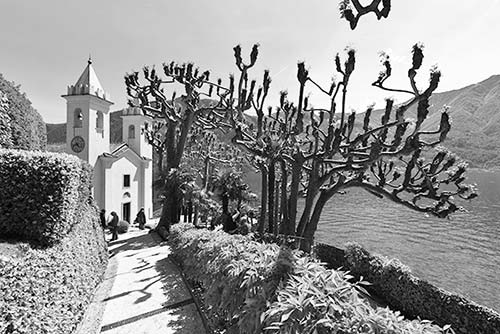
The 50-minute tour of the villa is as fascinating as its larger-than-life former owner. You’ll tour the loggia (with a library and a study), then spend the rest of the time seeing 18 of the main building’s 25 rooms. While finely decorated, these feel cozy, lived-in, and not too extravagant. Each one gives you a bit more insight into Monzino—from his personal living quarters, to his extensive collection of prehistoric artifacts from around the world, to the top-floor museum of his expeditions, with memorabilia from his North Pole and Mount Everest adventures. You’ll see secret passages, learn why his furniture came with handles, and find out what’s hiding behind the faux bookcase.
Menaggio—the third of the “big three” mid-lake towns (along with Varenna and Bellagio)—has more urban bulk than its neighbors, but visitors are charmed by its lovely lakefront park. Since many find Lake Como too dirty for swimming, consider spending time in Menaggio’s fine public pool (look for the lido). This is the starting point for a few hikes. (Just a few decades ago, cigarette smugglers used these trails at night to sneak back into Italy from Switzerland with their tax-free booty.) The TI has information about mountain biking and catching the bus to trailheads on nearby Mount Grona. Ask for the free Walking in the Province of Como booklet, with information on 18 different walks detailing historical, artistic, and natural features (TI on Piazza Garibaldi, tel. 034-432-924, www.menaggio.com, infomenaggio@tiscali.it).
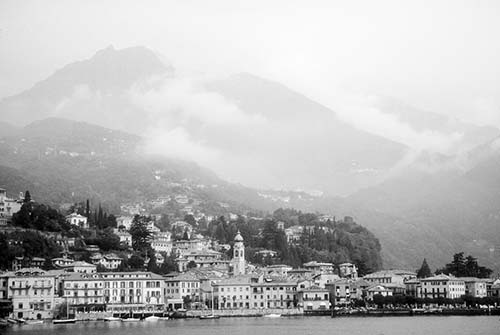
Sleeping in Menaggio: ¢ La Primula Youth Hostel is a classic, old-school hostel, offering sailing lessons, Italian-language courses, cooking classes, kayak and bike rentals, and a great location on the lake, a two-minute walk from the ferry dock (Via IV Novembre 106, tel. 0344-32356, www.lakecomohostel.com, info@lakecomohostel.com).
Menaggio Connections: In addition to being connected to Varenna and Bellagio by all the regular boats, bus #C10 connects Menaggio to Como town in about an hour (1-2/hour). Menaggio is also a springboard for visiting Switzerland. In summer, the yellow Palm Express bus runs once daily to St. Moritz (3.5 hours; off-season runs only weekends; reservations are required, www.postauto.ch or PostBus app)—remember to bring your passport. A bus (#C12) goes to Lugano (nearly hourly, 1 hour, €7). It’s a 10-minute or so walk into town from the ferry dock and then a bit confusing (buy bus tickets in front of the main church at La Provincia bar; the bus stop is 100 yards uphill from there).
On the southwest tip of the lake, Como has a good, traffic-free old town, an interesting Gothic/Renaissance cathedral, a cable car up to a mountaintop viewpoint, and a pleasant lakefront with a promenade (TI at Piazza Cavour 17, tel. 031-269-712, www.lakecomo.it). It’s an easy 10-minute walk from the boat dock to the train station (trains to Milan depart about twice per hour, 45 minutes). For details on boats connecting Como to Bellagio and Varenna, see here.
From Varenna or Bellagio, you can make a loop that lets you nip into Switzerland to see the elegant lake resort of Lugano, pass through the town of Como, and cruise a good part of Lake Como. Here’s a good day plan (times are approximate—confirm schedules locally): about 9:30—ferry to Menaggio (15 minutes from Varenna); 10:30—bus to Lugano (1 hour, bring your passport); 11:30—explore Lugano; 16:00—train to Como (45 minutes); 17:00/18:00/19:00—fast hydrofoil from Como to Varenna (1 hour). For more information on Lugano, see www.ricksteves.com/lugano.
Lake Maggiore is ringed by mountains, snowcapped in spring and fall, and lined with resort towns such as Stresa. Although Lake Maggiore lacks the cozy charm of Lake Como, a visit here may be worth the trouble for two islands, both with exotic gardens and lovely villas built by the Borromeo family.
The Borromeos—through many generations since 1630—lovingly turned their islands into magical retreats, with elaborate villas and fragrant gardens. Isola Bella has a palace and terraced garden; Isola Madre has a villa and sprawling English-style (more casual) garden. A third island, Isola Superiore (a.k.a. Isola Pescatori), is simply small, serene, and residential. The Borromeos, who made their money from trade and banking, enjoyed the arts—from paintings (hung in lavish abundance throughout the palace and villa) to plays (performed in an open-air theater on Isola Bella) and marionette shows (you’ll see the puppets that once performed here). Although it’s a characterless resort, the town of Stresa is a handy departure point for exploring Lake Maggiore’s exotic garden islands.
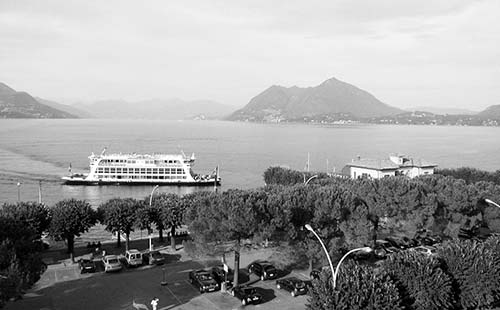
Tourists flock here in May and June, when flowers are in bloom, and in September. Concerts held in scenic settings draw music lovers, particularly during the summer Stresa Festival (get details from Stresa TI). For fewer crowds, visit in April, July, August (when Italians prefer the Mediterranean beaches), or October. In winter, the snow-covered mountains (with resorts a 1.5-hour drive away) attract skiers.
This region is best visited on a sunny day, when the mountains are clear, the lake is calm, and the heat of the sun brings out the scent of the blossoms. The two top islands for sightseeing are Isola Bella and Isola Madre (if tight on time, focus on Isola Bella). Isola Superiore has no sights but is a peaceful place for lunch. You can stay the night in Stresa, but a day trip is sufficient for most.
Day Trip from Milan: Catch the one-hour, early train from Milan to the town of Stresa (usually at 8:25, which may require reservations, and likely also at 9:29—but check times carefully, as there’s often a midmorning gap until 11:25). Upon arrival in Stresa, walk 10 minutes downhill to the boat dock, and catch a boat to Isola Madre. Work your way back to Isola Superiore for a lazy lunch, and then go on to Isola Bella for the afternoon, before returning to Stresa and back to Milan (trains leave about hourly—jot down your departure options upon arrival in Stresa).
Boats link the islands and Stresa, running about twice hourly. Allow roughly 10 minutes between stops. Buy a free circulation ticket, which allows you to get off and on at intermediate stops between your departure and arrival ports (€13.80 includes Bella and Superiore, €16.90 covers all the islands, and €20.70 includes the islands and Villa Taranto).
Boats run daily April through September. The map on here shows most of the route: Stresa, Carciano/Lido (at the base of the cable car—but most boats skip this stop), Isola Bella, Isola Superiore, Baveno (lakeside town), Isola Madre, Pallanza, and Villa Taranto. This route is part of a longer one. To follow the boat schedule (free, available at boat docks and the TI), look at the Arona-Locarno timetable for trips from Stresa to the islands, and the Locarno-Arona timetable for the return trip to Stresa. Off-season, the boats cover a shorter route (public boat info: tel. 0322-233-200, www.navigazionelaghi.it).
Buy boat tickets directly from the dock ticket booth under the gallery to the left of the TI. On the promenade to the boat dock, don’t be fooled by the private taxi-boat drivers, most dressed in sailor outfits—they’ll try to talk you into paying way too much for private tours on their smaller boats.
Don’t linger in Stresa—it’s just a functional springboard. The main attractions are the islands and gardens.
The town of Stresa—which means “thin stretch”—was named for the original strip of fishermen’s huts that lined the shore. Today, grand old hotels run along that same shore.
Arrival in Stresa: At the train station, ask for a free city map at the newsstand (to the far right of the tracks as you exit the train). To get downtown, exit right from the station and take your first left (on Viale Duchessa di Genova). This takes you straight down to the lake (once you’re there, the boat dock is about four blocks to your right; ask for boat schedule at ticket window). The helpful TI is located to the right of the ticket window at the boat dock (daily 10:00-12:30 & 15:00-18:30, off-season closed Sat afternoon and all day Sun, Piazza Marconi 16, tel. 0323-31308, www.stresaturismo.it). Taxis charge a fixed rate of €11 for even the shortest ride.
Visiting Stresa: The old town—basically a traffic-free touristy shopping mall—is just a few blocks deep, stretching inland from the main boat dock. Stresa’s stately 19th-century lakeside hotels date back to the days when this town was on the Grand Tour circuit.
In any Romantic Age resort like Stresa, hotels had names designed to appeal to Victorian aristocrats...like Regina Palace (rather than Palazzo), Astoria, Bristol, and Victoria.
The Grand Hotel des Iles Borromees was the first (built in 1862). In 1918, 19-year-old Ernest Hemingway—wounded in Slovenia as an ambulance driver for the Italian Red Cross—was taken to Stresa’s Grand Hotel des Iles Borromees, which served, like its regal neighbors, as an infirmary during World War I. Hemingway returned to the same hotel in 1948, stayed in the same room (#205, now called the “Hemingway suite”—you can stay there for a couple thousand dollars a night), and signed the guest book as “an old client.” Another “old client” was Winston Churchill, who honeymooned here.
A fine waterfront promenade leads past the venerable old hotels to the Lido, with the Carciano boat dock and the Stresa-Alpino-Mottarone cable car. This cable car takes you up—in two stages and a 20-minute ride—to the top of Mount Mottarone (€11.50 one-way, €20 round-trip, daily 9:30-17:30 in summer, shorter winter hours, 2-3/hour, bar midway up, tel. 0323-30295, www.stresa-mottarone.it). From the top (about 5,000 feet), you get great panoramic views of neighboring peaks and, by taking a short hike, a bird’s-eye view of the small, neighboring Lake Orta (described later).
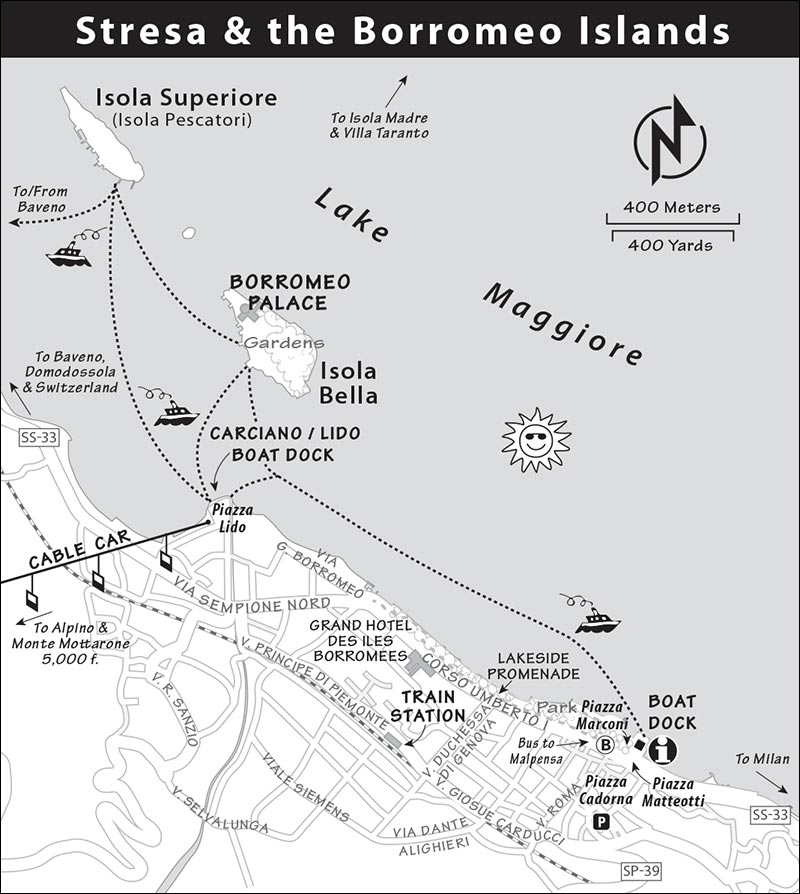
Halfway up the cable car line are the Alpine Gardens, which come with fine lake views and picnic spots, but can’t compare with what you’ll see on the islands. To visit the gardens, get off at the midway Alpino stop and walk 10 minutes (turn left as you leave; €4, daily 9:30-18:00, closed Nov-March). If you plan to hike down, pick up the Trekking map from the TI and allow four hours from the top of Mount Mottarone, or two hours from the Alpine Gardens (mountain biking also possible—ask at TI).
Sleeping in Stresa: Because Stresa’s town generally lacks appeal, I’d day-trip from Milan. But if you’d like to stay, here are some options: $$$ Hotel Milan Speranza au Lac is a big, group-oriented hotel facing the boat dock (www.milansperanza.it); $$ Hotel Saini Meublè is a small, homey, affordable choice in the old town center (www.hotelsaini.it); and $$ Hotel Moderno is a midsize, midrange option in the old town (www.hms.it).
Eating in Stresa: The main square, Piazza Cadorna, is one big tourist trap, yet it does have a certain charm. (At night, it seems anyone who claims to be a musician can get a gig singing for diners.) For a (slightly) less touristy alternative, seek out one of these options: $$ Osteria degli Amici, tucked away under a vine trellis on a forgotten square a couple of blocks beyond Piazza Cadorna (Via Bolongaro 33); $$ La Botte, with an old-school diner vibe on the main street between the port and the square (Via Mazzini 6); or $$$$ Il Clandestino, a fancier, romantic, modern splurge specializing in fish (Via Rosmini 5).
This island, nearest Stresa, has a formal garden and a fancy Baroque palace. Looking like a stepped pyramid from the water, the island was named by Charles Borromeo (sponsor of Milan’s Duomo) for his wife, Isabella. The island itself is touristy, with a gauntlet of souvenir stands and a corral of restaurants. A few back streets provide evidence that people actually live here. While the Borromeo family now lives in Milan, they spend a few weeks on Isola Bella each summer (when their blue-and-red family flag flies from the top of the garden).
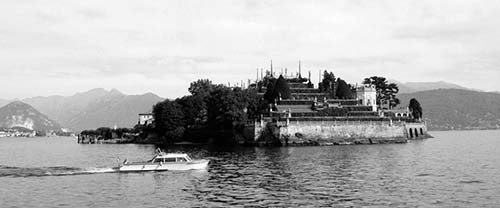
Cost and Hours: Palace and garden—€17, €24.00 combo-ticket includes villa at Isola Madre, daily 9:00-18:00, shorter hours for palace’s picture gallery, closed late Oct-late March, tel. 0323-30556, www.isoleborromee.it.
Tours: A fine €4 audioguide describes the palace, which also has posted English descriptions. A €1.50 booklet explains the gardens.
Eating: Several restaurants cluster between the boat docks and the villa. Picnicking is not allowed in the garden, but you can picnic in the pebbly park at the point of the island, beyond the villa (free and open to the public).
Visiting the Island: There are two docks on this island, one for each direction. It’s a short walk from the boat to the hulking villa (turn left from the dock; on the way, you’ll pass a public WC). Once inside, your visit is a one-way tour, starting with the palace and finishing with the garden. (There’s no way to see the garden without the palace.)
In the lavishly decorated Baroque palace, stairs lead up under stucco crests of Italy’s top families (balls signify the Medici, bees mean the Barberini, and a unicorn symbolizes the Borromeos’ motto: Humility). You’ll loop through the picture gallery, containing 130 beautifully restored 16th-century paintings from the Borromeo family’s private collection, hung wall-to-ceiling in several cramped rooms. Then you’ll get a peek at the canopied bedchambers and ogle the ornate throne room. Continue through the dining room, with a portrait of the first Borromeo, and into a richly stuccoed grand hall, with an 80-foot-high dome and featuring an 18th-century model of the villa, including a grand water entry that never materialized.
Next comes the music room, the site of the 1935 Stresa Conference, in which Mussolini met with British and French diplomats in a united attempt to scare Germany out of starting World War II. Look for a copy of the treaty with Mussolini’s signature on the wall next to the exit. Unfortunately, the “Stresa Front” soon fizzled, when Mussolini attacked Ethiopia and joined forces with Hitler.
Napoleon’s bedroom comes with an engraving that depicts his 1797 visit (Napoleon is on a bench with his wife and sister enjoying festivities in his honor). Continue through several more opulent halls, many of which display souvenirs and gifts that the Borromeo family picked up over the generations.
Downstairs, many of the famous Borromeo marionettes are on display. (A larger collection is on Isola Madre.) The 18th-century, multiroom grotto, decorated from ceiling to floor with shell motifs and black-and-white stones, still serves its original function of providing a cool refuge from Italy’s heat. The dreamy marble statues are by Gaetano Monti, a student of Antonio Canova. Climbing out of the basement, look up at the unique, cantilevered, spiral stairs; they’re from a 16th-century fortress that predates this building.
Pass through the mirrored corridor and follow the route through more rooms until you come to the ornate hall of 16th-century Flemish tapestries. This leads to the finale of this island visit: the beautiful garden, complete with Chinese white peacocks, which give it an exotic splash. (Before continuing to the garden, consider heading up the stairs near the WC to stroll through Elisa’s Greenhouse, named for Napoleon’s sister and home to tropical plants.)
From the palace, head straight up the stairs into the main part of the garden. Baroque—which is exactly what you see here—is all about controlling nature. The centerpiece is a pyramid-shaped outdoor grotto, crowned by the Borromeo family unicorn. Up the stairs and behind this fanciful structure is a vast terrace with views over the lower gardens and Stresa. Back downstairs, follow the signs (hidden in the bushes) to the café and bookshop, which anchor the far points of the island, to see the terraces behind the “pyramid.” Finally, follow exit signs to pop out a side gate at the top of a twisty, stepped lane back through town to the boat docks.
This sleepy island—home to 35 families—is the smallest and most residential of the three. It has a few good fish restaurants, ample pizza-by-the-slice takeout joints, picnic benches, views, and, blissfully, nothing much to do—all under arbors of wisteria. Simply stroll the narrow, cobbled lanes, or relax at the long, skinny, pebbly park/beach at the tip of the island. A delight for photographers and painters, the island is never really crowded, except at lunchtime.
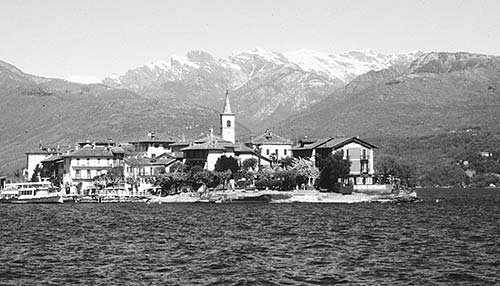
Don’t come to this island unless you intend to tour the sight, because that’s all there is: an interesting furnished villa (with a few sparse English descriptions) and a lovely garden filled with exotic birds and plants. Garden lovers can invest a few euros in a booklet about the plantings.
Cost and Hours: Villa and garden—€13.50, €24.00 combo-ticket includes Isola Bella, daily 9:00-18:00, closed late Oct-late March, tel. 0323-31261, www.isoleborromee.it.
Visitor Services: A WC is next to the chapel. You’ll also find a café/bookshop (selling basic sandwiches) just outside the villa. While eating is best on Isola Superiore, Isola Madre has one real restaurant, La Piratera Ristorante Bar, which owns a big, beautiful terrace over the lake. You’ll run into this immediately after leaving the villa/garden complex (good-value fixed-price tourist meal, daily 8:00-18:00, sit-down meals 12:00-15:30, simple sandwiches and slices of pizza-to-go anytime, picnic at the rocky beach a minute’s walk from the restaurant, just to your right as you exit the gardens, tel. 0323-31171).
Visiting the Island: Visiting is a one-way affair. From the boat dock, walk up the stairs to the ticket desk for the villa. Then, once through the gate, take the level path to the right to loop around the gardens and end at the villa (ingresso al giardino signs). Or, if you’re in a rush, take the stairs to the left instead to go straight to the villa.
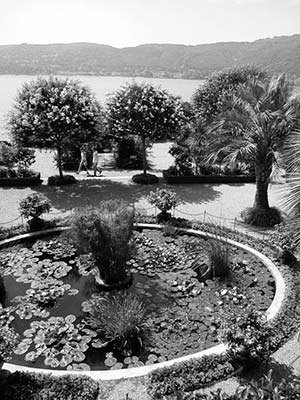
First you’ll circle all the way around the gardens. Eight gardeners (with the help of water continually pumped from the lake) keep this English-style garden paradise lush. It’s a joy, even for those bored by flowers and foliage. You’ll see trees from around the world, and an exotic bird menagerie with golden and silver pheasants and Chinese peacocks. (You’ll see and hear them roaming wild; also look for the bird cages partway up the main staircase to the villa, on the left.)
In front of the villa, a once-magnificent Himalayan cypress tree paints your world a streaky green. The 150-year-old tree, knocked down by a tornado in 2006 but successfully saved, is an attraction in its own right, with steel guy-wires now anchoring it firmly in place.
The 16th-century villa is the first of the Borromeo palaces, dating from the Renaissance. A century older than the Isola Bella villa, it’s dark and somber. The clever angled hinges keep the doors from flapping in the lake breeze. The family’s huge collection of dolls, marionettes, and exquisite 17th-century marionette theater sets—painted by a La Scala opera set designer—fills several rooms. A corner room is painted to take you into an 18th-century Venetian Rococo sitting room under a floral greenhouse.
Some of the garden’s best flowers are in view immediately after leaving the villa. Walk down the stairs to the terrace in front of the chapel, with WCs tucked around the left side. Stairs lead directly down to the boat dock from here. Or you can loop past the villa to exit at the far end, just above La Piratera restaurant. From there, you can walk through the shop to reach a terrace path that leads you back to the boat dock.
Garden lovers will enjoy this large landscaped park, located on the mainland across the lake from Stresa. Although it’s the most sprawling garden in the area, and enjoyable for a stroll in a park, it’s a bit underwhelming. The gardens are a Scotsman’s labor of love. Starting in the 1930s, Neil McEacharn created this garden of delights—bringing in thousands of plants from all over the world—and here he stays, in the small mausoleum. The park’s highlight is a terraced garden with a series of cascading pools. Villa Taranto is directly across the street from the boat dock.
Cost and Hours: €11, daily 8:30-18:30, Oct 9:00-16:00, closed Nov-mid-March, tel. 0323-404-555, www.villataranto.it.
Getting There: It’s two stops (about 15 minutes) past Isola Madre. On the way, you’ll pass a scenic promontory speckled with villas. Note that only about half of the lake boats stop here, which means an hour between return departures—check schedules carefully.
Just on the other side of Mount Mottarone is the small Lake Orta. The lake’s main town, Orta San Giulio, has a beautiful lakeside piazza ringed by picturesque buildings. The piazza faces the lake with a view of Isola San Giulio. Taxi boats (€4 round-trip) make the five-minute trip throughout the day. The island is worth a look for the Church of San Giulio and the circular “path of silence,” which takes about 10 minutes. In peak season, Orta is anything but silent, but off-season or early or late in the day, this place is full of peace and magic (TI on Via Panoramica next to the parking lot downhill from the train station, www.orta.net [URL inactive], tel. 0322-905-163; there’s another near the town center at Via Bossi 11, tel. 0322-90155).
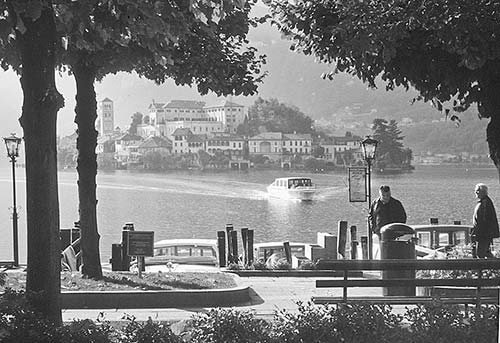
Getting There: The train ride from Stresa to Orta-Miasino (a short walk from the lakeside piazza) takes 1.5-2 hours and requires a change or two (5/day). Public buses from Stresa’s Piazza Marconi to Orta depart from near the TI (around €10 round-trip, about 1 hour, 2-3/day mid-June-mid-Sept, confirm schedule at TI or at www.safduemila.com).